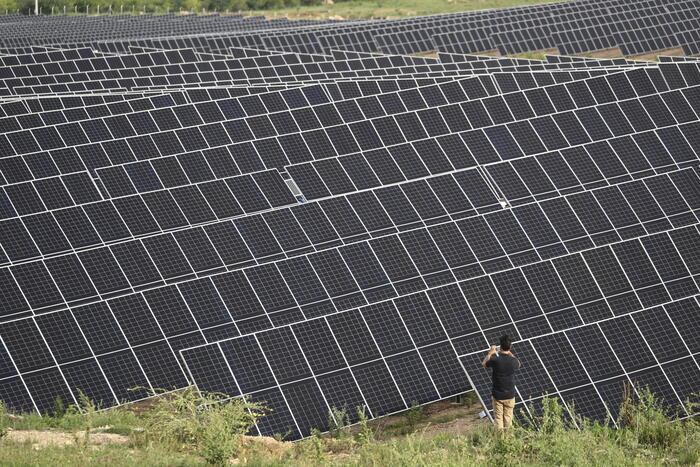Installation of a solar park of the Italian Enel, in Coahuila. ALFREDO ESTRELLA (AFP/Getty Images)
Mexico has given surprise at COP 27. After building a huge refinery and paralyzing private investment in renewable energy, the Mexican government wanted to show the world that it takes the environment seriously.
During the climate summit in Egypt, he has pledged to cut polluting gas emissions by 35% and double renewable generation by 2030. Environmental experts and organizations applaud the announcement, but say this will require a radical and rapid shift in the energy policy of President Andrés Manuel López Obrador, highly focused on fossil fuels.
The Latin American country had not updated its targets for reducing polluting emissions since 2015, when it committed to a 22% cut by 2030. In 2020, the Government presented a goal that, instead of reducing, allowed it to pollute 14 million tons of CO₂ more than expected, according to Greenpeace.
The NGO now declares itself pleasantly surprised by the announcement in Egypt.
"We thought they would maintain the 2015 objectives. The news of 35% exceeds our expectations," says Pablo Ramírez, climate change coordinator.
It is not the only surprise.
To achieve the ambitious cut in emissions, the Mexican government proposes a swerve in the energy sector, the one that pollutes the most along with transport.
The Executive undertakes to eliminate gas flaring at Pemex facilities, and to add 30 gigawatts of renewable capacity in eight years.
At the end of 2021, wind, solar, geothermal, and hydroelectric capacity totaled 26.8 gigawatts, 31% of the total installed capacity.
In other words, the new commitment means more than doubling the current figure.
If it is fulfilled, in 2030 Mexico could cover more than half of its consumption from renewables.
The goal, while impressive, clashes with the energy policy of the last four years.
At the beginning of the six-year term, López Obrador proposed to increase oil production and "rescue" Pemex - the emissions of the parastatal have doubled since then.
Then, the president canceled the long-term electricity auctions, a mechanism that catapulted the expansion of private renewable plants in the country, and introduced regulatory changes to favor the plants of the Federal Electricity Commission (CFE) over private ones, although the the former were more polluting.
In addition, he has hindered or delayed the granting of permits for plants already built.
The result of this policy has been a halt in private investment in the energy sector.
From 5,000 million dollars in 2018, this has plummeted to 452 in 2021. The fall has resulted in a brake on the growth of renewables.
In 2021, 1,372 GWh were added in wind generation, compared to 2,976 in 2020 and 4,291 in 2019. As for solar, 4,359 more GWh were generated in 2021, compared to 5,871 in 2020 and 6,753 in 2019. For To finish off, the last Program for the Development of the National Electric System (Prodesen), a document that is published annually, indicated that the clean generation goal for 2024 -35% of the total- was going to be achieved in 2031, seven years after.
The setback has worried the US government, which has responded with one of lime and another of rice.
On the one hand, it has opened commercial consultations under the TMEC against legal changes in the Mexican energy sector.
On the other, John Kerry, President Joe Biden's special envoy for climate, has become one of the US officials who has met with López Obrador the most times in the last two years.
Kerry's good nature appears to have accomplished a few tweaks to the president's energy agenda.
In a joint meeting at the end of October, Foreign Minister Marcelo Ebrard promised "accelerated" growth in clean energy.
As proof of the environmental turn, the Mexican authorities have presented the Sonora Plan.
The program includes the exploration of lithium, the production of semiconductors and, above all, the construction of the largest solar plant in Latin America.
However, reaching 30 gigawatts in eight years would mean building 30 plants of that size.
The CFE, which reported losses of more than 50,000 million pesos in the third quarter, has not revealed other renewable projects.
In fact, its business plan for 2022 to 2026 only called for the modernization of already existing hydroelectric plants, and the construction of 14 gas-fired combined cycle plants.
Adding 30 gigawatts requires, experts warn, an immediate shift in the strategy followed by the Government so far.
Analyst Víctor Ramírez says that the announced increase is viable, but only if private investment is unblocked.
“It is possible if there is a radical change in policy from 2023. Between the time you start planning a wind project until you put it into operation, it takes no less than five or six years.
The plots, four years at least, ”he says.
“The Government has to start holding auctions.
I don't see any other way."
For now, the Executive has not mentioned the possibility of returning to the auction system.
On the other hand, building plants is not everything.
New transmission lines are also needed to transport power from production sites to consumption centers.
This has been a demand from the renewable sector for years, but at the beginning of the six-year term the Government canceled the construction of two important transmission lines.
If you want to reach an additional 30 gigawatts in 2030, these projects will have to be rescued.
"You need an investment in transmission to relieve electricity generation points, but the CFE does not have the capacity or the resources to do everything," says Jorge Villarreal, from the NGO Iniciativa Climática.
In the announcement of the new commitments, Mexico says it has submitted a "preliminary investment plan" of up to $48 billion.
It is a considerable budget, but the details are not known and it has not been clarified if it will be public or private money, Mexican or American, or a mixture of everything.
“We have just received a very promising pump.
Now, the important thing is to know how it is articulated in the technical part”, says Ramírez, from Greenpeace.
subscribe here
to the EL PAÍS México
newsletter
and receive all the key information on current affairs in this country



/cloudfront-eu-central-1.images.arcpublishing.com/prisa/CL7NM42NLBG2BDOKOLOEFR4OCY.JPG)









